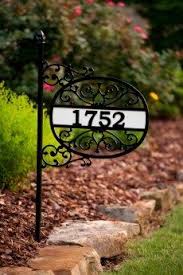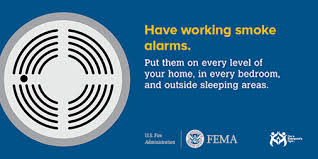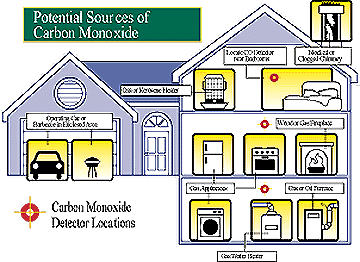|
FIRE SAFETY
Is your house number up to code?

CODE OF THE TOWN OF LEWISBORO
Chapter 186: SIGNS FOR E911 IDENTIFICATION
§ 186-3. Requirements for residential districts.
| A. |
Each driveway access must be identified by an E911 number displayed on a driveway location sign in the following manner:
| (1) |
E911 driveway location signs must be a minimum of 3 1/2 inches high and 7 1/2 inches long. The maximum size is 8 1/2 inches high and 11 inches long. |
| (2) |
Signs must be reflective and shall combine numbers which are at least 2 1/2 inches high and have a minimum stroke width of 1/2 inch against a contrasting background. |
| (3) |
Driveway location signs must be mounted back to back on their supports so that they are legible from vehicles approaching from either direction on the road. |
| (4) |
All materials used in the construction of E911 identification signs should be impervious to outdoor weather conditions. |
|
| B. |
Placement of driveway location signs in residential districts shall be according to the following requirements:
| (1) |
Wherever possible, E911 driveway location signs shall be installed on the left side of each driveway access as determined by facing the driveway from the road. In cases where it is physically impossible to comply with this requirement, alternative locations shall be approved by the Building Inspector after consultation with the respective Fire Chief. |
| (2) |
Driveway location signs must be placed within five feet of the edge of pavement on the road and within five feet of the driveway surface, so as to clearly identify the driveway access. |
| (3) |
Signs must be installed at right angles to the road so they can be read from vehicles approaching from either direction on the road. |
| (4) |
Signs must be a minimum of 24 inches and a maximum of 40 inches above the ground. Sign visibility must be maintained in all weather conditions by the homeowner. |
| (5) |
Driveway location signs, as described in Subsection A(1) through (4) above, may be displayed on mailbox supports below the box or on the sides of the box itself, on fence posts or gate posts, etc., only when the location of the supporting structure is on the same side of the road as the driveway, is located to the left and within five feet of the driveway, clearly identifies the driveway access, permits the sign to meet the height requirements, is installed at right angles to the road and is legible from vehicles approaching from either direction on the road. Groups of mailboxes are not acceptable for driveway identification purposes. Mailboxes may be identified with numbers to facilitate mail delivery, but they are not acceptable to provide driveway identification unless they stand alone and meet the criteria listed above. |
| (6) |
Exceptions. Mailboxes presently located to the right of driveway access points but otherwise meeting the requirements of sign location as in Subsection B(1) through (5) above may be used to post driveway identification numbers until such time as the box and/or its support needs to be replaced. It must then be moved to the left of the access point as in Subsection B(1) through (5) above. |
§ 186-8. Waivers.
A property owner may apply to the Building Department for a waiver from strict compliance with the requirements of this chapter. The Building Inspector may grant the waiver only if, after referral to the appropriate Fire Chief, a letter is received from the Fire Chief indicating that the location of the E911 identification is satisfactory to the Fire Chief.
|
PULL OVER PLEASE!

Did you know that there is one thing everyone can do to help your fire department provide emergency assistance as quickly as possible? It is as simple as moving your vehicle to the right for passing sirens and lights!
An emergency vehicle (police, fire truck, or ambulance) comes up behind you on the roadway, what do you do?
New York State vehicle and traffic law article 26, section 1144 states that all vehicles must yield the right of way to any vehicle displaying one or more red lights. Yielding the right of way consists of pulling over to the right where and when it is safe and coming to a stop. At an intersection all traffic is required to come to a stop and yield the way to the emergency vehicle.
NYS V&T LAWS
§ 1144. Operation of vehicles on approach of authorized emergency vehicles.
(a) Upon the immediate approach of an authorized emergency vehicle equipped with at least one lighted lamp exhibiting red light visible under normal atmospheric conditions from a distance of five hundred feet to the front of such vehicle other than a police vehicle or bicycle when operated as an authorized emergency vehicle, and when audible signals are sounded from any said vehicle by siren, exhaust whistle, bell, air-horn or electronic equivalent; the driver of every other vehicle shall yield the right of way and shall immediately drive to a position parallel to, and as close as possible to the right-hand edge or curb of the roadway, or to either edge of a one-way roadway three or more lanes in width, clear of any intersection, and shall stop and remain in such position until the authorized emergency vehicle has passed, unless otherwise directed by a police officer.
§ 1218. Crossing fire hose.
No vehicle shall be driven over any unprotected hose of a fire department when laid down on any street or private driveway, to be used at any fire or alarm of fire, without the consent of the fire department official in command.
§ 1217. Following emergency fire vehicles prohibited.
The driver of any vehicle other than one on official business shall not follow any authorized emergency fire vehicle in the same lane or an adjacent lane to the one being used by such fire vehicle at a distance closer than two hundred feet while such fire vehicle is displaying one or more red or combination red and white lights, or one white light which must be a revolving, rotating, flashing, oscillating or constantly moving light, nor shall such driver drive into or park his or vehicle within the block or where there is no block, within one thousand feet of where such fire vehicle has stopped in answer to a fire alarm.
FIRE ALARMS
 Fire alarms systems should be updated regularly. Please make sure you contact your alarm company to update your information. Fire alarms systems should be updated regularly. Please make sure you contact your alarm company to update your information.
Changes may include:
- Updated phone numbers
- New/updated key holders
- Additions to your home or change of zones
- Do they have the correct address information (house #, correct road), Spring St. South is not the same address as Spring St. This could delay the fire departments response during an emergency.
- Alarm company emergency contact number for the South Salem Fire Department is (914) 763-3700.
Regular service is necessary to maintain proper operation of your alarm system, contact your alarm company to find out when yours is due for service.
CHECK YOUR SMOKE DETECTORS
It is recommended that you change the batteries in all your smoke detectors and carbon monoxide alarms twice a year. This can be remembered by changing the batteries when you change your clocks in the spring and again in the fall.

Remember:
- You should also test your smoke detectors once a month, following the manufacturer's instructions.
- Never "borrow" a battery from a smoke alarm. Smoke alarms can't warn you of fire if their batteries are missing or have been disconnected.
- Don't disable smoke alarms even temporarily.
- Regularly vacuuming or dusting your smoke alarms, following the manufacturer's instructions, can keep them working properly.
- Smoke alarms don't last forever. Replace yours once every 10 years. If you can't remember how old the alarm is, then it's probably time for a new one.
NFPA (National Fire Protection Agency) Facts
- An estimated 890 lives could be saved each year if all homes had working smoke alarms.
- 65% of reported home fire deaths in 2000-2004 resulted from fires in homes with no smoke alarms or no working smoke alarms.
- The fire death rate in homes with working smoke alarms is 51% less than the rate for homes without this protection.
- In one out of every five homes equipped with at least one smoke alarm installed, not a single one was working.
- Why do smoke alarms fail? Most often because of missing, disconnected or dead batteries. Nuisance activations were the leading cause of disabled smoke alarms.
- A 2004 telephone survey found that 96% of U.S. households had at least one smoke alarm, yet in 2000-2004, no smoke alarms were present or none operated in almost half (46%) of the reported home fires.
CARBON MONOXIDE
NFPA (National Fire Protection Association) Research and Reports
Often called the silent killer, carbon monoxide is an invisible, odorless, colorless gas created when fuels (such as gasoline, wood, coal, natural gas, propane, oil, and methane) burn incompletely. In the home, heating and cooking equipment that burn fuel are potential sources of carbon monoxide. Vehicles or generators running in an attached garage can also produce dangerous levels of carbon monoxide.

|




